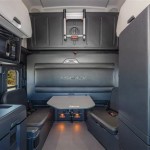Paint Sprayer For Interior Walls: A Comprehensive Guide
Achieving a professional-looking paint job on interior walls can be a challenging task. Traditional methods, such as brushes and rollers, often require significant time and effort, and can sometimes result in uneven finishes. Paint sprayers offer an alternative approach, promising efficiency, speed, and a smoother, more consistent application. This article explores the world of paint sprayers specifically designed for interior walls, examining their types, benefits, drawbacks, and factors to consider when selecting the right tool for the job.
Paint sprayers work by atomizing paint into a fine mist, which is then propelled onto the surface. This method allows for a more even coat compared to brushes or rollers, which can leave behind brush strokes or roller marks. The result is often a smoother, more professional finish that can be achieved in a fraction of the time. However, it's important to understand that not all paint sprayers are created equal, and choosing the right one for interior walls is crucial for optimal results.
Several types of paint sprayers are available on the market, each with its own set of advantages and disadvantages. These include airless sprayers, HVLP (High Volume Low Pressure) sprayers, and pneumatic sprayers. Understanding the differences between these technologies is essential for making an informed decision.
Types of Paint Sprayers for Interior Walls
Airless sprayers are known for their power and efficiency, making them suitable for large-scale projects. These sprayers use high pressure to atomize the paint, forcing it through a small nozzle without the need for compressed air. This results in a fast application and a thick, even coat. Airless sprayers are particularly well-suited for covering large areas quickly, such as entire rooms or multiple walls.
One of the key advantages of airless sprayers is their ability to handle a wide range of paint viscosities, including thicker paints that may be difficult to apply with other types of sprayers. This versatility makes them a popular choice for both professionals and DIY enthusiasts. However, airless sprayers also have their drawbacks. They tend to produce more overspray than other types of sprayers, which can lead to wasted paint and require more extensive masking and preparation. Cleaning airless sprayers can also be a more involved process, requiring specific solvents and tools.
HVLP sprayers, on the other hand, use a high volume of air at low pressure to atomize the paint. This results in a softer, more controlled spray with significantly less overspray compared to airless sprayers. HVLP sprayers are ideal for projects that require a fine finish and precise control, such as trim work, cabinetry, or applying delicate coatings. They are also a good choice for beginners, as the reduced overspray makes them more forgiving to use.
The downside of HVLP sprayers is that they typically have a slower application rate than airless sprayers, and they may not be suitable for very thick paints. They also require a separate air compressor, which can add to the overall cost and complexity. However, for interior wall projects where precision and minimal overspray are paramount, HVLP sprayers are often the preferred choice.
Pneumatic sprayers, also known as compressed air sprayers, are similar to HVLP sprayers in that they require an air compressor to operate. However, they typically operate at higher pressures than HVLP sprayers, resulting in a faster application rate and a wider spray pattern. Pneumatic sprayers are often used for automotive painting and other industrial applications, but they can also be used for interior wall painting. They offer a good balance between speed and control, although they may produce slightly more overspray than HVLP sprayers.
The choice between airless, HVLP, and pneumatic sprayers depends on the specific requirements of the project, the user's skill level, and the desired finish. Airless sprayers are best for large-scale projects where speed and efficiency are key, while HVLP sprayers are ideal for projects requiring precision and minimal overspray. Pneumatic sprayers offer a compromise between the two, providing a good balance of speed and control.
Benefits of Using a Paint Sprayer for Interior Walls
One of the most significant benefits of using a paint sprayer is the speed at which it can cover large areas. Compared to traditional brushes and rollers, paint sprayers can significantly reduce the time required to paint an entire room or house. This is especially beneficial for large-scale projects or for those who want to complete their painting quickly.
Another advantage is the smooth, even finish that paint sprayers can achieve. The fine mist of paint ensures that the surface is coated uniformly, eliminating brush strokes and roller marks. This results in a professional-looking finish that is difficult to achieve with traditional methods. The even coating also helps to improve the durability of the paint, as there are no thin spots that are more susceptible to wear and tear.
Paint sprayers can also reach areas that are difficult to access with brushes or rollers. This includes corners, edges, and textured surfaces. The ability to spray paint into these areas ensures that the entire surface is coated evenly, resulting in a more complete and professional-looking finish. This is particularly useful for walls with intricate moldings or textured finishes.
Furthermore, paint sprayers can often save on paint consumption. While it may seem counterintuitive, the even application of paint sprayers can actually reduce waste. By applying a consistent and uniform coat, paint sprayers minimize the risk of over-application or uneven coverage, both of which can lead to unnecessary paint usage.
Factors to Consider When Choosing a Paint Sprayer
Before purchasing a paint sprayer for interior walls, it is essential to consider several factors to ensure that you choose the right tool for the job. These factors include the size of the project, the type of paint you will be using, your budget, and your skill level.
The size of the project is a crucial factor to consider. For small projects, such as painting a single room or a small section of wall, a smaller, more portable sprayer may be sufficient. However, for larger projects, such as painting an entire house, a more powerful and efficient sprayer is necessary. Airless sprayers are typically better suited for larger projects, while HVLP sprayers are more appropriate for smaller, more detailed work.
The type of paint you will be using is also an important consideration. Some sprayers are better suited for certain types of paint than others. For example, airless sprayers can handle a wider range of paint viscosities, including thicker paints, while HVLP sprayers are typically better suited for thinner paints. It is important to check the manufacturer's recommendations to ensure that the sprayer is compatible with the paint you intend to use.
Budget is always a factor when making any purchase, and paint sprayers are no exception. Paint sprayers range in price from relatively inexpensive models to high-end professional-grade equipment. It is important to set a budget before you start shopping and to stick to it. However, it is also important to remember that you often get what you pay for. Investing in a higher-quality sprayer may ultimately save you money in the long run by providing better performance, durability, and ease of use.
Your skill level is another important consideration. Some paint sprayers are easier to use than others. If you are a beginner, you may want to choose a sprayer that is known for its ease of use and forgiving operation. HVLP sprayers, with their reduced overspray, are often a good choice for beginners. It is also important to practice using the sprayer on a scrap piece of material before you start painting your interior walls. This will allow you to get a feel for the sprayer and to adjust the settings to achieve the desired finish.
Beyond these core considerations, several other factors can influence your choice. The availability of replacement parts and accessories is an important consideration, as is the ease of cleaning and maintenance. Some sprayers require more extensive cleaning than others, and it is important to choose a sprayer that you are comfortable cleaning and maintaining. The weight and portability of the sprayer are also factors to consider, especially if you will be moving the sprayer around frequently. Finally, it is always a good idea to read reviews and compare different models before making a purchase.
Ultimately, selecting the right paint sprayer for interior walls requires careful consideration of various factors. By understanding the different types of sprayers available, their benefits and drawbacks, and the specific requirements of your project, you can make an informed decision and achieve a professional-looking paint job. Preparation and practice are also crucial for success. Proper masking and surface preparation will help to minimize overspray and ensure a smooth, even finish. Practicing with the sprayer on a scrap piece of material will allow you to fine-tune your technique and avoid common mistakes.

How To Spray Paint Interior Walls In Depth Guide And Tricks

How To Spray Paint Interior Walls Paintenance Melbourne

Should You Use A Sprayer For Interior Walls Semigloss Design

All About How And Why To Use A Paint Sprayer Your Home

Best Paint Sprayer Airless Electric In 2024 Brad The Painter

How To Paint Interior Trim With A Sprayer Wagner Spraytech

Beginner Guide To Painting Interior Walls With A Sprayer Lemon Thistle

How To Use A Paint Sprayer Hvlp Hea Airless Wagner Diy Best Interior Wall Spray

Paint Sprayer For Interior Walls Tutorial Magnum By Graco

Spray Everything Fine Homebuilding








